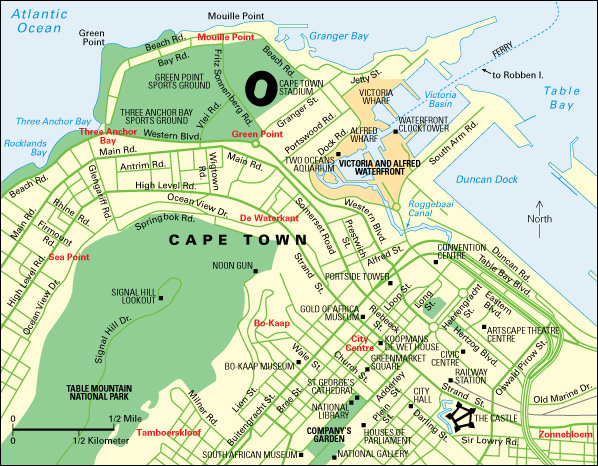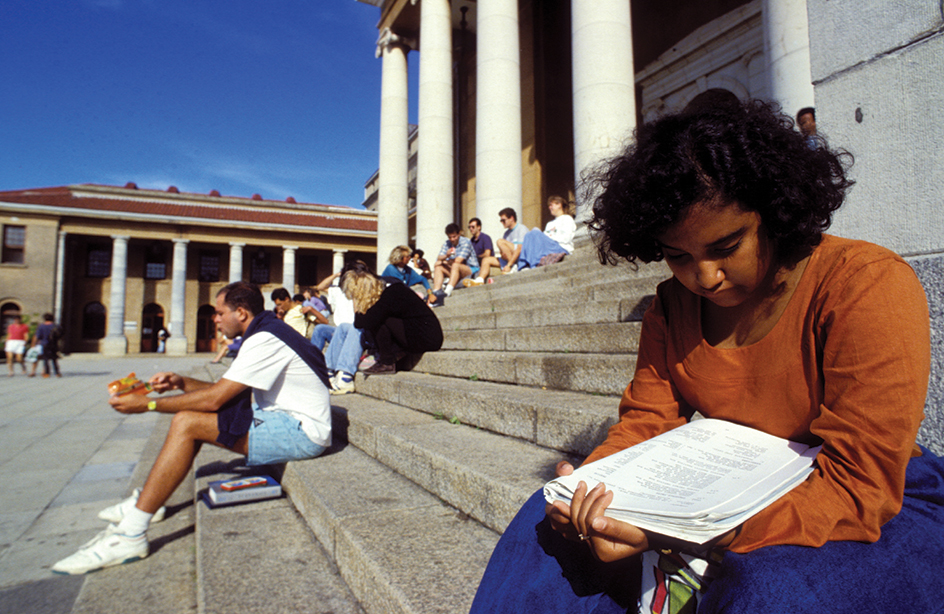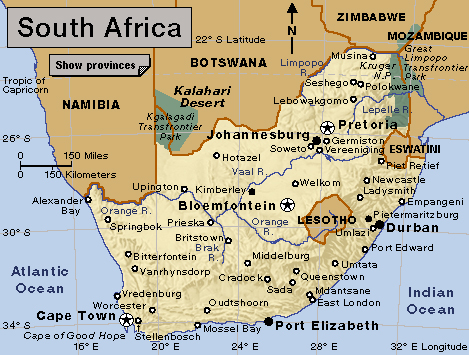Cape Town (pop. 4,772,846) is the legislative capital of South Africa and one of the country’s largest cities. Parliament meets in Cape Town. South Africa’s administrative capital is Pretoria, and its judicial capital is Bloemfontein. Cape Town is also the capital of the province of Western Cape.
Cape Town lies near the southwestern tip of Africa, close to the meeting point of the Atlantic and Indian oceans. It lies next to one of the world’s main shipping routes. Cape Town is often called “the mother city” because it was the first place in South Africa to be settled by Europeans. The Dutch East India Company, a trading firm, founded the Cape Colony in 1652 at the present site of Cape Town.
The city
occupies the Cape Peninsula, also called the Cape of Good Hope, and much of the surrounding area. The peninsula extends south from Table Mountain, which overlooks the Cape Town city center. The southern tip of the peninsula is called Cape Point. The Cape Peninsula forms the west side of False Bay. Cape Town stretches from Cape Point to just north of the community of Mamre, a distance of about 50 miles (80 kilometers). The city also wraps around False Bay. The city covers a total of 965 square miles (2,499 square kilometers). Rural areas and national parkland make up some parts of Cape Town. Robben Island lies in Table Bay, north of Table Mountain. The sea temperature on the Atlantic side of Cape Town is generally about 10 °F (5 °C) cooler than the temperature of False Bay. Winters in Cape Town are cool and wet, and summers are warm and dry. 
The city center, wedged between Table Mountain and the harbor, consists of a mixture of modern skyscrapers and old historic buildings. The Atlantic seaboard has excellent scenery and beaches. Chapman’s Peak Drive is a spectacular scenic route that runs between the Cape Town communities of Houtbaai and Noordhoek. Several communities on the False Bay coast, such as Simon’s Town and Fish Hoek, are popular with tourists.
Numerous other communities lie within the Cape Town municipal limits. In the mid-1990’s, after the end of South Africa’s system of racial segregation called apartheid, communities that surrounded the central city of Cape Town merged to form a greater Cape Town. Some of these communities had been separate apartheid areas for Coloured (mixed-race) people. Others had been set aside for Black Africans. The most desirable areas had been reserved for the white minority.
To the east of Cape Town lie the separate towns of Stellenbosch, Paarl, and Franschhoek, all noted for wine and fruit. North of the city is the Swartland, centered on Malmesbury. The Swartland produces wheat and other grains.
Places of interest.
Cape Town’s natural beauty, sandy beaches, and sunny climate make it one of the world’s major tourist destinations. One of the city’s most popular sites is the historic harbor area, today called the Victoria and Alfred Waterfront. It features a shopping mall, restaurants, an aquarium, and other attractions. Ferries leave from the Waterfront to tour Robben Island. The maximum security prison on the island is now a museum. During the apartheid years, many antiapartheid activists, including Nelson Mandela, were imprisoned there.
Cape Town’s botanical gardens originated with a hedge planted by Dutch settler Jan van Riebeeck in 1660. The Castle, built between 1666 and 1679, is South Africa’s oldest surviving building. Groot Constantia was built in 1685 on Governor Simon van der Stel’s farm. Today, it is the oldest homestead in South Africa, and the farm is the country’s oldest vineyard.
The Rhodes Memorial, on the slopes of Devil’s Peak in the community of Rondebosch, was dedicated in 1912 in honor of Cecil Rhodes, who served as prime minister of the Cape Colony from 1890 to 1895. Since 1929, Cape Town has had a cable car that takes visitors up about 3,000 feet (910 meters) to the summit of Table Mountain. Groote Schuur Hospital is where the South African surgeon Christiaan Barnard performed the world’s first human heart transplant in 1967.
Cape Town’s architecture reflects the city’s rich cultural and ethnic diversity. The city has many fine buildings, including the Houses of Parliament and several museums, cathedrals, and mosques (Muslim houses of worship). Some Cape Town houses have graceful, rounded gables patterned after the Dutch-style homes of the original European settlers. Other houses in the city are ornate Victorian and stately Georgian homes built by later British settlers.
The people
of Cape Town come from a variety of ethnic and social backgrounds. Coloured people, who are of mixed African, European, and Asian ancestry, make up about 35 percent of the city’s population. Some are so-called Cape Malays, whose ancestors included enslaved people brought mainly from South and Southeast Asia between the 1600’s and early 1800’s. Most Cape Malays are Muslims, and many of them live in the Bo-Kaap area (also called the Malay Quarter) on the slopes of Signal Hill.
About 45 percent of Cape Town’s people are of African descent. Most of them belong to the Xhosa ethnic group. During the apartheid era, which began in the late 1940’s, the entry of Black Africans into the Cape was strictly controlled.
About 15 percent of Cape Town’s people are of European descent. Their ancestors came mainly from France, Germany, the Netherlands, and the United Kingdom. Some people of Indian ancestry also live in the city.
Afrikaans is the leading language in Cape Town, followed by Xhosa and English. Most people speak more than one language. English is the primary language used in commerce.
Education and culture.
The South African College, the oldest surviving school in South Africa, opened in Cape Town in 1829. The University of Cape Town grew out of this school, becoming an independent university in 1918. It is one of the oldest universities in Africa. The main campus is at Rhodes’s Groote Schuur Estate, on the slopes of Devil’s Peak in Rondebosch. The University of the Western Cape, originally set aside for Coloured people during the apartheid era, is in the community of Bellville.

In 1658, the first school in Cape Town was opened for the children of enslaved people. A school for the children of settlers opened a few years later. Today, Cape Town has many primary and secondary schools. But schools in informal settlements are often overcrowded and poorly equipped.
Cape Town has many libraries, museums, and art galleries. The South African Museum is the nation’s main natural history museum. The Planetarium is part of this museum. The South African National Gallery features works by South African artists. The Gold of Africa Museum features beautiful artworks made out of gold. The Artscape Theatre Centre and Baxter Theatre feature opera, ballet, music, and drama. There are several street markets, including Greenmarket Square and the Grand Parade.
Economy.
Cape Town is South Africa’s second largest port in area, after Durban. Because of its strategic position on world trade routes, it was for hundreds of years the gateway to southern Africa. The harbor provides a safe anchorage and fresh supplies for visiting ships. It also offers a wide range of facilities, including dry docks and fueling, loading, cooling, repairing, and salvage operations. The port can also accommodate supertankers that are too large to pass through the Suez Canal in Egypt.
Cape Town has a mixed economy. The economy was originally based on agriculture, but other industries have become more important. Service industries, including banking, finance, and real estate, dominate the economy. Since the end of apartheid, the tourism industry also has become important to the economy. Factories in Cape Town produce a variety of goods, such as chemicals, food products, machine parts, petroleum products, and textiles. Government-related activities also employ many workers.
Koeberg, South Africa’s only nuclear power station, lies near the Cape Town community of Melkbosstrand. Cape Town International Airport is the country’s second largest airport, after Johannesburg’s. The luxurious Blue Train travels to and from Cape Town. One train line connects Cape Town with Port Elizabeth, and another line connects Cape Town with Johannesburg and Pretoria.
Government.
Cape Town is one of South Africa’s six metropolitan municipalities. The others are Johannesburg; eThekwini, which includes the city of Durban; Ekurhuleni, also known as the East Rand; Tshwane, which includes the city of Pretoria; and Nelson Mandela Bay, which includes the city of Port Elizabeth. A mayor and a municipal council oversee the Cape Town municipality. Cape Town is the legislative capital of the Republic of South Africa. The Houses of Parliament, completed in 1885, house the country’s National Assembly.

History.
Archaeologists believe that Stone Age cave dwellers lived in the Cape Town region about 120,000 years ago. The earliest records of the San people living in the Cape Town area are from about 26,000 years ago (see San). The Khoikhoi people have been living in the area around Cape Town for about 1,500 years (see Khoikhoi; Khoisan).

The Portuguese explorer Bartolomeu Dias, who sailed around the cape in 1488, is said to have named it Cabo da Boa Esperança (Cape of Good Hope) because he hoped it lay on the way to the riches of Asia. After Antonio de Saldanha, another Portuguese explorer, visited the area in 1503, it was sometimes referred to as Agoada da Saldanha (Watering Place of Saldanha). In 1580, the English explorer Sir Francis Drake reached the region. A Dutch navigator, Joris van Spilbergen, named the area Table Bay in 1601, after its flat-topped hill known as Table Mountain.
Jan van Riebeeck, an employee of the Dutch East India Company, founded Cape Town. He arrived in April 1652 to set up a refreshment station for the company. Cape Town is still known as the Tavern of the Seas. By 1657, the first farmers had settled along the banks of the Liesbeeck River. In 1658, about 400 enslaved people arrived from West Africa. Additional enslaved people were brought in from India, Indonesia, and other parts of South and Southeast Asia. Huguenots (French Protestant refugees) added a French flavor to Cape Town after they settled there in 1688.
From 1795 to 1803, the British occupied Cape Town. The town was part of the Batavian Republic from 1803 to 1806, after which the British reoccupied it. In 1814, the Dutch ceded the Cape to the United Kingdom. In 1840, Cape Town was declared a municipality. In 1872, the Cape Colony received responsible government, which meant that the locally elected government could make decisions on most matters without consulting the British government.
In 1910, the Cape Colony became part of the Union of South Africa, a self-governing country within the British Empire. South Africa gained complete legislative independence from the United Kingdom in 1931 and became a republic in 1961. By 2001, the boundaries of Cape Town had been extended to include surrounding communities populated chiefly by Coloureds and Black Africans.
In the late 2010’s, continuing droughts and a sharp rise in population contributed to a severe water shortage in Cape Town. The city avoided an immediate crisis as residents restricted their water usage and rainfall increased. The city also implemented longer term solutions. It introduced efficiencies to its water supply and drainage infrastructure, modernizations that helped conserve water as drier than normal conditions continued in the early 2020’s.
